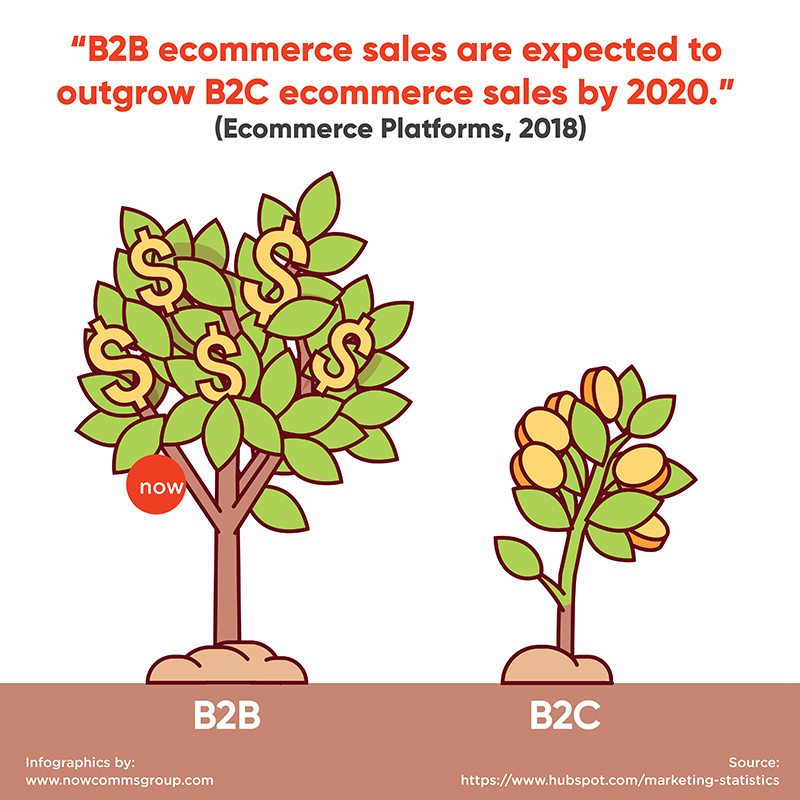Effective tips to grow your B2B Customer base in 2020
The days when the job of your business was “to sell” and the job of your customers was “to be sold to” are long gone. The game has changed, thanks to digital. Contemporary audiences now have the tech to go out and look for what they want in the online arena. With B2B Customers spending 27% of their time researching independently online before spending 17% of their time meeting potential suppliers. By the same token, businesses are now able to use the Internet and interactive technology to reach the customers that need them directly and more easily. With the relationship between customers and service providers now a highly nuanced one, it’s essential that businesses have the necessary digital sales and marketing infrastructure to find, connect and fully engage their customers. If your business doesn’t have the necessary tech in place, there’s a real risk of getting left behind!
Here are five suggestions that will place your company in a stronger position in 2020 to effectively grow and engage with your B2B Customers.
1. Define your target audience
Are you completely clear who your audience is? It’s often tempting to widen the net and go after every customer. But it’s a bit of a scattergun approach and you’ll end up wasting lots of effort and money in the long run. I’d start by identifying who your most ideal B2B Customers are and then who within that business are the ideal people that need your goods or services. Try to put yourself in their shoes and describe their world as much as you can. The more you can describe who they are, how they think, how they behave, what their attitudes are like, and what their pain points are, the more you can understand how your business can help solve their problems; and then make a sale.
2. Make sure your website keeps improving
Ask yourself, is my current website easily navigable? User-friendly? Responsive? Optimised for search? Does it have the right content and content type that my audience prefers? Your website needs to be all these things and more. If your customers can’t find what they need when they come to your website, it’s easy for them to simply go elsewhere. With so little time to make the right impression, it’s vital that you keep monitoring and improving your website on a regular basis (which could be daily, weekly, or monthly depending on your purchase cycle). Make sure you have Google Analytics tracking set-up correctly on your website (remember garbage-in, garbage-out) and that you teach yourself how to read the analytics results. That way you can use the results to further improve your website experience. Also don’t forget to make sure it’s clear where customers can leave their contact data so that you can get in touch with them.
3. Use a CRM platform
Designed to facilitate the relationship between your business and your B2B Customers at every stage of the purchase funnel, a CRM platform is a must in today’s world. There are a wide range of CRM options available, from enterprise level to good free platforms for SMB, so there is no excuse to avoid having one. Using a CRM platform (Hubspot is our favourite at the moment for it’s ease of implementation and use), enables you to collect valuable data on your target audience, track conversations and potential deals, and link the data with your inbound and outbound marketing activities – giving you the much needed intelligence to implement informed, more effective sales activities.
4. Hang out online with your audience
If you want to engage effectively with your B2B Customer, it’s important to be where they are! Social media is one place to see and be seen. LinkedIn is the most popular platform for professional audiences. So if you don’t already have a profile, now is the time to get active. Regular updates, comments, joining groups of interest, whitepapers, tips and tricks, and specific review pieces are all ways to get involved with your audience. Most importantly, being genuine, helpful, well-informed, engaging and entertaining is the best way to appeal to your target audience.
5. Evaluate regularly and adjust
Keeping track of your stats is crucial in order to chart progress and work out how to improve. Regularly monitoring data and the changes which occur when you implement new ways of working is vital in order to decide what works and what doesn’t. In today’s digital world, you can adjust course instantly with the push of an ‘update’ or ‘edit’ button on your website or social channels. Learn to love looking at the data, because it will tell you what’s going on and potentially the secret to winning the next B2B Customer sale.
Thanks for reading this article. I hope you have found something useful to implement or take onboard. Remember that with the new digital world, you can keep tweaking, adding, deleting and updating whenever you like. The trick is to make sure you do, so the next potential customers see your best content.
For more information on how to improve your inbound marketing, lead generation, and social media marketing, please get in touch with us via the contact us form below.
Categories
- Content (5)
- Customer Service (2)
- Design (4)
- Development (8)
- Digital Marketing (17)
- Ecommerce (23)
- Martech (16)
- Shopify (2)
- Strategy (22)
- Websites (15)




